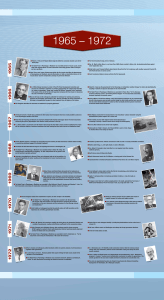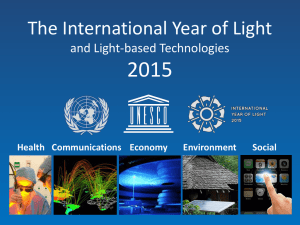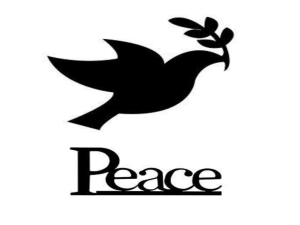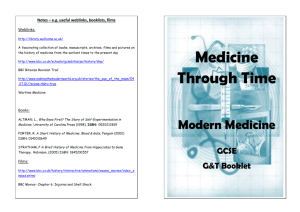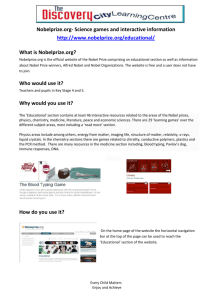Nobel Laureates
advertisement
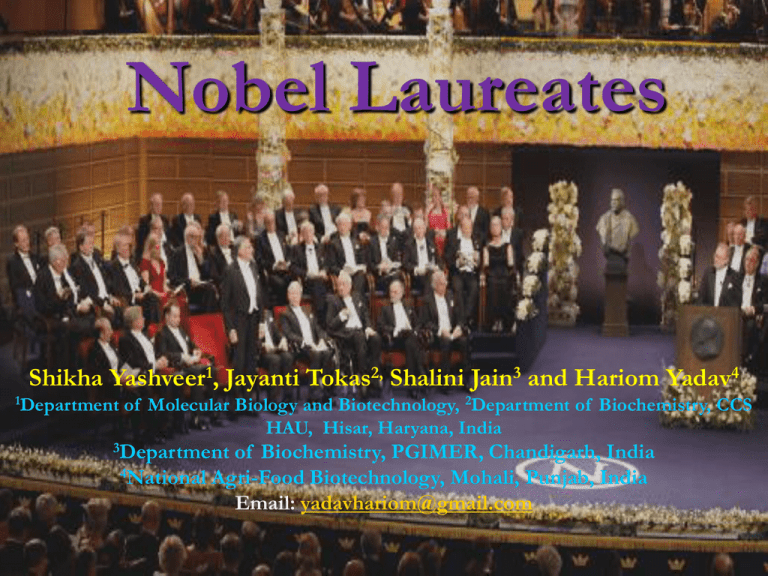
Nobel Laureates Shikha Yashveer1, Jayanti Tokas2, Shalini Jain3 and Hariom Yadav4 1Department of Molecular Biology and Biotechnology, 2Department of Biochemistry, CCS HAU, Hisar, Haryana, India 3Department of Biochemistry, PGIMER, Chandigarh, India 4National Agri-Food Biotechnology, Mohali, Punjab, India Email: yadavhariom@gmail.com Alfred Nobel Alfred Nobel was born on 21 October 1833 in Stockholm, Sweden, into a family of engineers. He was a chemist, engineer, and inventor. The will of the Swedish chemist Alfred Nobel, the inventor of dynamite, established the prizes in 1895. In 1888, Alfred was astonished to read his own obituary, titled ‘The merchant of death is dead’, in a French newspaper. MEDAL FOR THE NOBEL PRIZE IN PHYSIOLOGY AND MEDICINE FRONT BACK NOBEL PRIZE IN PEACE NOBEL PRIZE IN ECONOMICS NOBEL PRIZE IN CHEMISTRY AND PHYSICS HERMANN EMIL FISCHER The Nobel Prize in Chemistry 1902 was awarded to Emil Fischer “in recognition of the extraordinary services he has rendered by his work on sugar and purine syntheses’’ (1898). Ilya Ilyich Mechnikov Paul Ehrlich The Nobel Prize in Physiology or Medicine 1908 was awarded jointly to Ilya Ilyich Mechnikov and Paul Ehrlich in recognition of their work on immunity (1882). Albrecht Kossel The Nobel Prize in Physiology or Medicine 1910 was awarded to Albrecht Kossel "in recognition of the contributions to our knowledge of cell chemistry made through his work on proteins, including the nucleic substances" (1896). Frederick Grant Banting John James Rickard Macleod The Nobel Prize in Physiology or Medicine 1923 was awarded jointly to Frederick Grant Banting and John James Rickard Macleod "for the discovery of insulin” (1916). Willem Einthoven The Nobel Prize in Physiology or Medicine 1924 was awarded to Willem Einthoven for his discovery of the mechanism of the electrocardiogram (1903). Father of electrocardiography Karl Landsteiner The Nobel Prize in Physiology or Medicine 1930 was awarded to Karl Landsteiner "for his discovery of human blood groups” (1900). Thomas Hunt Morgan The Nobel Prize in Physiology or Medicine 1933 was awarded to Thomas H. Morgan "for his discoveries concerning the role played by the chromosome in heredity" (1910). MULLER The Nobel Prize in Physiology or Medicine 1946 was awarded to Hermann J. Muller "for the discovery of the production of mutations by means of X-ray irradiation” (1926). Hans Adolf Krebs Fritz Albert Lipmann The Nobel Prize in Physiology or Medicine 1953 was divided equally between Hans Adolf Krebs "for his discovery of the citric acid cycle" and Fritz Albert Lipmann "for his discovery of coenzyme A and its importance for intermediary metabolism” (1930). Lord(Alexander R.)Todd The Nobel Prize in Chemistry 1957 was awarded to Lord Todd "for his work on nucleotides and nucleotide co-enzymes” (1949). Frederick Sanger The Nobel Prize in Chemistry 1958 was awarded to Frederick Sanger "for his work on the structure of proteins, especially that of insulin" (1945). George Wells Beadle Edward Lawrie Tatum Joshua Lederberg The Nobel Prize in Physiology or Medicine 1958 was divided, one half jointly to George Wells Beadle and Edward Lawrie Tatum "for their discovery that genes act by regulating definite chemical events" and the other half to Joshua Lederberg "for his discoveries concerning genetic recombination and the organization of the genetic material of bacteria". (1951) Severo Ochoa Arthur Kornberg The Nobel Prize in Physiology or Medicine 1959 was awarded jointly to Severo Ochoa and Arthur Kornberg "for their discovery of the mechanisms in the biological synthesis of ribonucleic acid and deoxyribonucleic acid (1956). A scientist shouldn't be asked to judge the economic and moral value of his work. All we should ask the scientist to do is find the truthand then not keep it from anyone. Arthur Kornberg quotes Francis Harry Compton Crick James Dewey Watson Maurice Hugh Frederick Wilkins The Nobel Prize in Physiology or Medicine 1962 was awarded jointly to Francis Harry Compton Crick, James Dewey Watson and Maurice Hugh Frederick Wilkins "for their discoveries concerning the molecular structure of nucleic acids and its significance for information transfer in living material” (1953). PERUTZ MAX FERDINAND KENDREW The 1962 Nobel prize in Chemistry was divided equally between: Perutz and Kendrew, Great Britain, Laboratory of Molecular Biology, Cambridge "for their studies of the structures of globular proteins". DOROTHY HODGKIN The 1964 Nobel prize in Chemistry was awarded to HODGKIN, DOROTHY CROWFOOT, "for her determinations by X-ray techniques of the structures of important biochemical substances". François Jacob André Lwoff Jacques Monod The Nobel Prize in Physiology or Medicine 1965 was awarded jointly to François Jacob, André Lwoff and Jacques Monod "for their discoveries concerning genetic control of enzyme and virus synthesis" (1961). Robert W. Holley Har Gobind Khorana Marshall W. Nirenberg The Nobel Prize in Physiology or Medicine 1968 was awarded jointly to Robert W. Holley, Har Gobind Khorana and Marshall W. Nirenberg "for their interpretation of the genetic code and its function in protein synthesis’’ (1961) Max Delbrück Alfred D. Hershey Salvador E. Luria The Nobel Prize in Physiology or Medicine 1969 was awarded jointly to Max Delbrück, Alfred D. Hershey and Salvador E. Luria "for their discoveries concerning the replication mechanism and the genetic structure of viruses“(1952). Norman E. Borlaug The Nobel Peace Prize 1970 was awarded to Norman Borlaug. Developed semi-dwarf, high-yield, disease-resistant wheat varieties in Mexico. He was awarded the Padma Vibhushan, India's second highest civilian honor. World Food Prize (1986). Earl W. Sutherland, Jr. The Nobel Prize in Physiology or Medicine 1971 was awarded to Earl W. Sutherland, Jr. "for his discoveries concerning the mechanisms of the action of hormones“(1953). Gerald M. Edelman Rodney R. Porter The Nobel Prize in Physiology or Medicine 1972 was awarded jointly to Gerald M. Edelman and Rodney R. Porter "for their discoveries concerning the chemical structure of antibodies“ (1960). Christian B. Anfinsen Stanford Moore William H. Stein The Nobel Prize in Chemistry 1972 was divided, one half awarded to Christian B. Anfinsen "for his work on ribonuclease, especially concerning the connection between the amino acid sequence and the biologically active conformation", the other half jointly to Stanford Moore and William H. Stein "for their contribution to the understanding of the connection between chemical structure and catalytic activity of the active centre of the ribonuclease molecule". (1962) Albert Claude Christian de Duve George E. Palade The Nobel Prize in Physiology or Medicine 1974 was awarded jointly to Albert Claude, Christian de Duve and George E. Palade "for their discoveries concerning the structural and functional organization of the cell". George Emil Palade (November 19, 1912 – October 8, 2008) was a Romanian cell biologist. Described as "the most influential cell biologist ever”. The prize was granted for his innovations in electron microscopy and cell fractionation which together laid the foundations of modern molecular cell biology, the most notable discovery being the ribosomes of the endoplasmic reticulum – which he first described in 1955. Palade also received the U.S. National Medal of Science in Biological Sciences for "pioneering discoveries of a host of fundamental, highly organized structures in living cells" in 1986, and was previously elected a Member of the US National Academy of Science in 1961. David Baltimore Renato Dulbecco Howard Martin Temin The Nobel Prize in Physiology or Medicine 1975 was awarded jointly to David Baltimore, Renato Dulbecco and Howard Martin Temin "for their discoveries concerning the interaction between tumour viruses and the genetic material of the cell". (1968) Roger Guillemin Andrew V. Schally Rosalyn Yalow The Nobel Prize in Physiology or Medicine 1977 was divided, one half jointly to Roger Guillemin and Andrew V. Schally "for their discoveries concerning the peptide hormone production of the brain" and the other half to Rosalyn Yalow "for the development of radioimmunoassays of peptide hormones". (1950) Werner Arber Daniel Nathans Hamilton O. Smith The Nobel Prize in Physiology or Medicine 1978 was awarded jointly to Werner Arber, Daniel Nathans and Hamilton O. Smith "for the discovery of restriction enzymes and their application to problems of molecular genetics".1970 Paul Berg Walter Gilbert Frederick Sanger The Nobel Prize in Chemistry 1980 was divided, one half awarded to Paul Berg "for his fundamental studies of the biochemistry of nucleic acids, with particular regard to recombinant-DNA", the other half jointly to Walter Gilbert and Frederick Sanger "for their contributions concerning the determination of base sequences in nucleic acids“ (1972). Aaron Klug The Nobel Prize in Chemistry 1982 was awarded to Aaron Klug "for his development of crystallographic electron microscopy and his structural elucidation of biologically important nucleic acid-protein complexes". (1978) Barbara McClintock The Nobel Prize in Physiology or Medicine 1983 was awarded to Barbara McClintock "for her discovery of mobile genetic elements". 1948 Niels K. Jerne Georges J.F. Köhler César Milstein The Nobel Prize in Physiology or Medicine 1984 was awarded jointly to Niels K. Jerne, Georges J.F. Köhler and César Milstein "for theories concerning the specificity in development and control of the immune system and the discovery of the principle for production of monoclonal antibodies". 1975 Stanley Cohen Rita Levi-Montalcini The Nobel Prize in Physiology or Medicine 1986 was awarded jointly to Stanley Cohen and Rita LeviMontalcini "for their discoveries of growth factors " J. Michael Bishop Harold E. Varmus The Nobel Prize in Physiology or Medicine 1989 was awarded jointly to J. Michael Bishop and Harold E. Varmus "for their discovery of the cellular origin of retroviral oncogenes“ 1976 Sidney Altman Thomas R. Cech The Nobel Prize in Chemistry 1989 was awarded jointly to Sidney Altman and Thomas R. Cech "for their discovery of catalytic properties of RNA”1980. Joseph E. Murray E. Donnall Thomas The Nobel Prize in Physiology or Medicine 1990 was awarded jointly to Joseph E. Murray and E. Donnall Thomas "for their discoveries concerning organ and cell transplantation in the treatment of human disease" Erwin Neher Bert Sakmann The Nobel Prize in Physiology or Medicine 1991 was awarded jointly to Erwin Neher and Bert Sakmann "for their discoveries concerning the function of single ion channels in cells“ 1970 Richard R. Ernst The Nobel Prize in Chemistry 1991 was awarded to Richard R. Ernst "for his contributions to the development of the methodology of high resolution nuclear magnetic resonance (NMR) spectroscopy". Edmond H. Fischer Edwin G. Krebs The Nobel Prize in Physiology or Medicine 1992 was awarded jointly to Edmond H. Fischer and Edwin G. Krebs "for their discoveries concerning reversible protein phosphorylation as a biological regulatory mechanism" Richard J. Roberts Phillip A. Sharp The Nobel Prize in Physiology or Medicine 1993 was awarded jointly to Richard J. Roberts and Phillip A. Sharp "for their discoveries of split genes. 1978 Kary B. Mullis Michael Smith The Nobel Prize in Chemistry 1993 was awarded "for contributions to the developments of methods within DNA-based chemistry" jointly with one half to Kary B. Mullis "for his invention of the polymerase chain reaction (PCR) method" and with one half to Michael Smith "for his fundamental contributions to the establishment of oligonucleotide-based, site-directed mutagenesis and its development for protein studies". Alfred G. Gilman Martin Rodbell The Nobel Prize in Physiology or Medicine 1994 was awarded jointly to Alfred G. Gilman and Martin Rodbell "for their discovery of G-proteins and the role of these proteins in signal transduction in cells" Edward B. Lewis Christiane Nüsslein-Volhard Eric F. Wieschaus The Nobel Prize in Physiology or Medicine 1995 was awarded jointly to Edward B. Lewis, Christiane Nüsslein-Volhard and Eric F. Wieschaus "for their discoveries concerning the genetic control of early embryonic development". Stanley B. Prusiner The Nobel Prize in Physiology or Medicine 1997 was awarded to Stanley B. Prusiner "for his discovery of Prions a new biological principle of infection". 1982. Robert F. Furchgott Louis J. Ignarro Ferid Murad The Nobel Prize in Physiology or Medicine 1998 was awarded jointly to Robert F. Furchgott, Louis J. Ignarro and Ferid Murad "for their discoveries concerning nitric oxide as a signalling molecule in the cardiovascular system". Gunter Blobel The Nobel Prize in Physiology or Medicine 1999 was awarded to Gunter Blobel "for the discovery that proteins have intrinsic signals that govern their transport and localization in the cell".1990 Arvid Carlsson Paul Greengard Eric R. Kandel The Nobel Prize in Physiology or Medicine 2000 was awarded jointly to Arvid Carlsson, Paul Greengard and Eric R. Kandel "for their discoveries concerning signal transduction in the nervous system and dopamine". Leland H. Hartwell Tim Hunt Sir Paul M. Nurse The Nobel Prize in Physiology or Medicine 2001 was awarded jointly to Leland H. Hartwell, Tim Hunt and Sir Paul M. Nurse "for their discoveries of key regulators of the cell cycle". Sydney Brenner H. Robert Horvitz John E. Sulston The Nobel Prize in Physiology or Medicine 2002 was awarded jointly to Sydney Brenner, H. Robert Horvitz and John E. Sulston "for their discoveries concerning 'genetic regulation of organ development and programmed cell death'". John B. Fenn Koichi Tanaka Kurt Wuthrich The Nobel Prize in Chemistry 2002 was awarded "for the development of methods for identification and structure analyses of biological macromolecules" with one half jointly to John B. Fenn and Koichi Tanaka "for their development of soft desorption ionisation methods for mass spectrometric analyses of biological macromolecules" and the other half to Kurt Wüthrich "for his development of nuclear magnetic resonance spectroscopy for determining the three-dimensional structure of biological macromolecules in solution". Paul C. Lauterbur Sir Peter Mansfield The Nobel Prize in Physiology or Medicine 2003 was awarded jointly to Paul C. Lauterbur and Sir Peter Mansfield "for their discoveries concerning magnetic resonance imaging" Andrew Z. Fire Craig C. Mello The Nobel Prize in Physiology or Medicine 2006 was awarded jointly to Andrew Z. Fire and Craig C. Mello "for their discovery of RNA interference - gene silencing by double-stranded RNA“ 1998 Roger D. Kornberg The Nobel Prize in Chemistry 2006 was awarded to Roger D. Kornberg "for his studies of the molecular basis of eukaryotic transcription". Mario R. Capecchi Sir Martin J. Evans Oliver Smithies The Nobel Prize in Physiology or Medicine 2007 was awarded jointly to Mario R. Capecchi, Sir Martin J. Evans and Oliver Smithies "for their discoveries of principles for introducing specific gene modifications in mice by the use of embryonic stem cells". Intergovernmental Panel on Climate Change (IPCC) Albert Arnold (Al) Gore Jr. The Nobel Peace Prize 2007 was awarded jointly to Intergovernmental Panel on Climate Change (IPCC) and Albert Arnold (Al) Gore Jr. "for their efforts to build up and disseminate greater knowledge about man-made climate change, and to lay the foundations for the measures that are needed to counteract such change" . The Intergovernmental Panel on Climate Change (IPCC) is a scientific intergovernmental body first established in 1988 by two United Nations organizations, the World Meteorological Organization (WMO) and the United Nations Environment Programme (UNEP), and later endorsed by the United Nations General Assembly. mission is to provide comprehensive scientific assessments of current scientific, technical and socio-economic information worldwide about the risk of climate change caused by human activity, its potential environmental and socio-economic consequences, and possible options for adapting to these consequences or mitigating the effects. It is chaired by Rajendra K. Pachauri. this involves the governments of more than 120 countries. A main activity of the IPCC is publishing special reports on topics relevant to the implementation of the United Nations Framework Convention on Climate Change (UNFCCC), an international treaty that acknowledges the possibility of harmful climate change. Website www.ipcc.ch Harald zur Hausen Françoise Barré-Sinoussi Luc Montagnier The Nobel Prize in Physiology or Medicine 2008 was divided, one half awarded to Harald zur Hausen "for his discovery of human papilloma viruses causing cervical cancer", the other half jointly to Françoise Barré-Sinoussi and Luc Montagnier "for their discovery of human immunodeficiency virus". Osamu Shimomura Martin Chalfie Roger Y. Tsien The Nobel Prize in Chemistry 2008 was awarded jointly to Osamu Shimomura, Martin Chalfie and Roger Y. Tsien "for the discovery and development of the green fluorescent protein, GFP". 1996. Elizabeth H. Blackburn Carol W. Greider Jack W. Szostak The Nobel Prize in Physiology or Medicine 2009 was awarded jointly to Elizabeth H. Blackburn, Carol W. Greider and Jack W. Szostak "for the discovery of how chromosomes are protected by telomeres and the enzyme telomerase". Venkatraman Ramakrishnan Thomas A. Steit Ada E. Yonath The Nobel Prize in Chemistry 2009 was awarded jointly to Venkatraman Ramakrishnan, Thomas A. Steitz and Ada E. Yonath "for studies of the structure and function of the ribosome". Robert G. Edwards The Nobel Prize in Physiology or Medicine 2010 was awarded to Robert G. Edwards "for the development of in vitro fertilization". British physiologist and pioneer in reproductive medicine and in-vitro fertilisation (IVF) . Bruce A. Beutler Jules A. Hoffmann Ralph M. Steinman The Nobel Prize in Physiology or Medicine 2011 was divided, one half jointly to Bruce A. Beutler and Jules A. Hoffmann "for their discoveries concerning the activation of innate immunity" and the other half to Ralph M. Steinman "for his discovery of the dendritic cell and its role in adaptive immunity". Sir John B. Gurdon Shinya Yamanaka The Nobel Prize in Physiology or Medicine 2012 was awarded jointly to Sir John B. Gurdon and Shinya Yamanaka "for the discovery that mature cells can be reprogrammed to become pluripotent" Thank You

